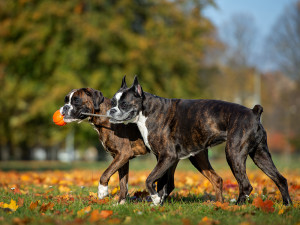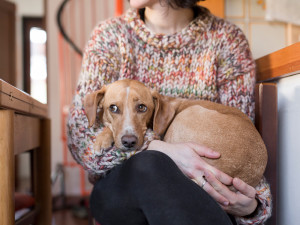Why Does My Dog Bark at the Postie?
How to get your pup and the postie to be friends

Share Article
It’s so clich�é, you almost can’t believe it’s real: your dog furiously barking at the postie or delivery person every time you have another Amazon package delivered (so twice a day). In addition to being concerned about the person’s well-being – and the future state of your Amazon deliveries – you’d like your pup to stop freaking out every time they see a delivery van.
If it’s any consolation, your dog is in good company with this reaction. It’s so common that the image of a dog barkingopens in new tab and charging a postie is a comic trope. But there’s nothing funny about it if it’s your dog – or if you’re the person delivering the packages. It’s a serious matter especially due to the potential for dog bites.
Why do dogs bark or bite postal workers?
For some dogs, the original barking is motivated by fear, while for others, it’s a territorial response. Other dogs lose control because the delivery pesson’s repeated appearances bring on a state of high arousal. The crazed behaviour can even be the result of frustration; some social dogs want nothing more than to make a new friend, but are continually thwarted by doors or gates or other barriers to contact.
It’s normal for a dog to bark to alert their social group to anyone approaching the house. What makes dog barking tricky is that from a dog’s point of view, the postie is a repeat offender who keeps coming on to their turf. Dogs rarely meet and get to know this individual, yet that person comes on to the property over and over again. What begins as an alerting behaviour can morph into wanting-to-eat-the-person displays as the dog learns that they bark and they go away. To us, that looks like two separate things, but to dogs, it looks like success: I bark, the person leaves. Dogs learn very quickly that barking will make the intruder go away.
The situation can become more serious when the dog acts this way around postal workers in other contexts. Some dogs learn to associate specific traits with negative feelings about the individual, and react whenever those triggers are present. Then you’ve got a dog who barks around anyone who looks like the postie, or who’s dressed in a similar way. Some dogs generalise with people who smell the same, perhaps from scents inside the van, a type of shampoo or deodorant. For other pups, any person carrying parcels and papers is treated like a delivery person. Generalising happens with the van, too. While some dogs distinguish between the delivery van and any other van, others begin to bark at all vans.
The majority of dogs who bite do so because they are afraid. Fearful dogs are often especially scared of people who are carrying things, which puts people who deliver the post at risk. Furthermore, these postal workers turn their backs and walk away, an action that can give frightened dogs just enough confidence to act on their fears by biting.
To both fearful and territorial dogs (as well as dogs with both issues), uniforms are often associated with unfamiliar people arriving on their property, so the uniform itself can be a trigger that elicits aggressive behaviour.
No matter why your dog is acting in this manner, there are things you can do to improve the dog barking and help your dog (and the delivery person) have better experiences when around each other.
How to stop excessive dog barking
Prevent your dog from engaging in the problematic behaviour.
If it has become a habit, you need to break the habit – and that means avoiding the problem so your dog doesn’t have yet another experience in which they successfully bark at the person as they go about their job.
Whether you keep your dog in a part of the house where they can’t see the post being delivered, or cover your windows with poster board to block their view, simple preventive actions will go a long way towards helping them overcome this.
Teach your dog a new response based on a new emotional reaction. If your dog is upset, fearful or irritated by the sight of the postal worker, they will continue to react by barking and growling. So, it’s critical to help your dog change the way they feel about the situation. That can be done by teaching your dog that every time a postie or delivery person shows up, they get their favourite thing. For most dogs, that favourite item is either treats (perhaps stuffed in a Kong for longer-lasting enjoyment) or a toy such as a tennis ball, squeaky fleece animal or a rope toy.
If the postie is willing, ask them to toss your pup the treats or a toy, since that’s the best way for them to learn to associate this person with good things. Just be aware that while some delivery people are willing to be involved in this process, others would rather face snow and rain and heat and the gloom of night. If that’s the case, you can dish out the treats while your delivery person safely places that Amazon package on your doorstep.

Karen B. London, PhD, CAAB, CPDT-KA
Karen B. London, Ph.D., is a Certified Applied Animal Behaviorist and Certified Professional Dog Trainer who specializes in working with dogs with serious behavioral issues, including aggression, and has also trained other animals including cats, birds, snakes, and insects.
Related articles
![pet lover concept with mini dog on woman leg. sitting in room at home]()
What’s the Deal, Mouthy Puppies? Why Bite Inhibition Matters
How to teach your pup to play nice
![Pet parent comforting anxious dog by holding their paw]()
8 Tips for Helping an Anxious Dog
Easy ways to calm your pup’s nerves
![A woman playing with her dog making a kiss face at it.]()
Here’s How You Can Avoid the Worst: a Dog Bite to the Face
Step one: never put your face close to theirs
![shy dog frightened in the arms of the owner. this brown mixed-breed hound puppy has a sweet gaze. the female owner has a wool sweater]()
Why Is My Dog Shaking? Causes and Treatment
A vet explains why the weather isn’t always to blame







